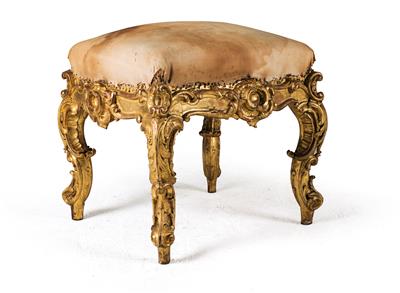Neo-Rococo tabouret or stool,

Presumably original furniture from Linderhof Palace, designed and produced by the workshops of Anton Pössenbacher circa 1873. A gold-painted serpentine lindenwood stool, richly carved with flowers and rocaille. 53 x 56 x 52 cm. Upholstered but without covers. Small losses, some flaking, some ageing and traces of wear. In the book “Möbel für den Märchenkönig - Ludwig II. und die Münchner Hofschreinerei Anton Pössenbacher” by Afra Schick (© Arnoldsche Art Publishers, Stuttgart and author, 2003) a stool (tabouret) is mentioned in the former “Weissen Kabinett” of Linderhof Palace alongside a console table. A photograph of Joseph Albert (before 1884) from the art library of the State Museums in Berlin, shows a stool matching the present piece. (DOC)
The works Lots 588–594 are presumed to be part of the original furnishings (construction period 1871 – 1873) of Linderhof Palace, built by King Ludwig II of Bavaria
King Ludwig II. of Bavaria
Ludwig II. Otto Friedrich Wilhelm von Wittelsbach, King of Bavaria, (* 25 August 1845 at Nymphenburg Palace, Nymphenburg, today Munich; † 13 June 1886 Würmsee [today Lake Starnberg] near Berg Castle), of the House of Wittelsbach, was King of Bavaria from 10 March 1864 until his death. After his deposition on 10 June 1886, his uncle Luitpold, as Prince Regent, took over the business of ruling in the Kingdom of Bavaria, since his younger brother Otto was incapable of ruling for reasons of insanity. Ludwig II. established himself in the history of Bavaria as the passionate builder of castles, in particular Neuschwanstein, Herrenchiemsee and Linderhof, for which reason he is popularly known as the Fairy Tale King. (from Wikipedia)
Linderhof Palace
Linderhof is the only palace to be completed under Ludwig II. and where the monarch resided for many years.
Constructed on the site of a hunting lodge in Graswangtal, which had been used by King Maximilian II., it underwent two building phases, in 1871 – 1873 and 1874 – 1877, and even then was not quite completed: from 1884 the king had the bedroom extended. The period of production for the furniture of the royal apartments on the upper floor, therefore, spans more than a decade.
Afra Schick: Möbel für den Märchenkönig, Ludwig II. und die Münchner Hofschreinerei Anton Pössenbacher, © 2003 Arnoldsche Art Publishers, Stuttgart and author.
Expert: Alexander Doczy
 Alexander Doczy
Alexander Doczy
+43-1-515 60-302
alexander.doczy@dorotheum.at
22.04.2015 - 15:00
- Dosažená cena: **
-
EUR 8.750,-
- Odhadní cena:
-
EUR 2.000,- do EUR 3.000,-
Neo-Rococo tabouret or stool,
Presumably original furniture from Linderhof Palace, designed and produced by the workshops of Anton Pössenbacher circa 1873. A gold-painted serpentine lindenwood stool, richly carved with flowers and rocaille. 53 x 56 x 52 cm. Upholstered but without covers. Small losses, some flaking, some ageing and traces of wear. In the book “Möbel für den Märchenkönig - Ludwig II. und die Münchner Hofschreinerei Anton Pössenbacher” by Afra Schick (© Arnoldsche Art Publishers, Stuttgart and author, 2003) a stool (tabouret) is mentioned in the former “Weissen Kabinett” of Linderhof Palace alongside a console table. A photograph of Joseph Albert (before 1884) from the art library of the State Museums in Berlin, shows a stool matching the present piece. (DOC)
The works Lots 588–594 are presumed to be part of the original furnishings (construction period 1871 – 1873) of Linderhof Palace, built by King Ludwig II of Bavaria
King Ludwig II. of Bavaria
Ludwig II. Otto Friedrich Wilhelm von Wittelsbach, King of Bavaria, (* 25 August 1845 at Nymphenburg Palace, Nymphenburg, today Munich; † 13 June 1886 Würmsee [today Lake Starnberg] near Berg Castle), of the House of Wittelsbach, was King of Bavaria from 10 March 1864 until his death. After his deposition on 10 June 1886, his uncle Luitpold, as Prince Regent, took over the business of ruling in the Kingdom of Bavaria, since his younger brother Otto was incapable of ruling for reasons of insanity. Ludwig II. established himself in the history of Bavaria as the passionate builder of castles, in particular Neuschwanstein, Herrenchiemsee and Linderhof, for which reason he is popularly known as the Fairy Tale King. (from Wikipedia)
Linderhof Palace
Linderhof is the only palace to be completed under Ludwig II. and where the monarch resided for many years.
Constructed on the site of a hunting lodge in Graswangtal, which had been used by King Maximilian II., it underwent two building phases, in 1871 – 1873 and 1874 – 1877, and even then was not quite completed: from 1884 the king had the bedroom extended. The period of production for the furniture of the royal apartments on the upper floor, therefore, spans more than a decade.
Afra Schick: Möbel für den Märchenkönig, Ludwig II. und die Münchner Hofschreinerei Anton Pössenbacher, © 2003 Arnoldsche Art Publishers, Stuttgart and author.
Expert: Alexander Doczy
 Alexander Doczy
Alexander Doczy
+43-1-515 60-302
alexander.doczy@dorotheum.at
|
Horká linka kupujících
Po-Pá: 9.00 - 18.00
kundendienst@dorotheum.at +43 1 515 60 200 |
| Aukce: | Starožitnosti (Nábytek, Sochařská díla) |
| Typ aukce: | Salónní aukce |
| Datum: | 22.04.2015 - 15:00 |
| Místo konání aukce: | Wien | Palais Dorotheum |
| Prohlídka: | 11.04. - 22.04.2015 |
** Kupní cena vč. poplatku kupujícího a DPH
Není již možné podávat příkazy ke koupi přes internet. Aukce se právě připravuje resp. byla již uskutečněna.
